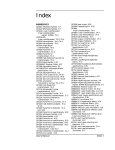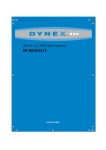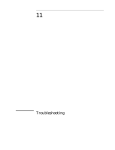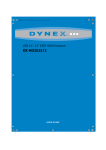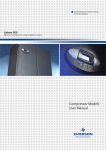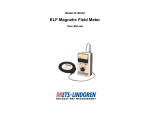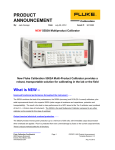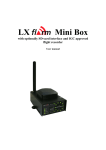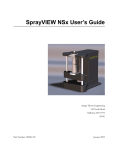Download Chapter 5 Laser Heads - Agilent Technologies
Transcript
5 Laser Heads Chapter 5 Laser Heads General General One laser head is required in most measurement systems, regardless of the number of measurement axes in the system. The wavelength of light from the laser head is used as the length standard for Agilent laser measurement systems. The laser head generates a coherent (all light waves in phase), collimated (all waves traveling parallel to one another), light beam consisting of two orthogonally polarized frequency components. To differentiate between the frequencies, the lower frequency is identified as f1 and the higher as f2. The difference between these two frequencies is the “Reference Frequency”, listed in Table 5-1. Agilent offers several laser head models to fill a variety of requirements. A summary listing of Agilent laser heads is provided in Table 5-1. In addition to system information for the laser heads, complete descriptions, equipment supplied information, and specifications for each laser heads are given in this chapter. Each of these laser heads requires a cable to connect it to the measurement system electronics. Cables are listed in Chapter 9, “Accessories,” of this manual. Table 5-1. Laser Heads Summary Agilent Model 5517A Reference Requency Beam Diameter Polarization Indicators Shutter 1.5 MHz to 6 mm f1 Horiz LASER ON f2 Vert READY Open, reduced, closed f1 Horiz +15V POWER ON f2 Vert −15V POWER ON 2.0 MHz 5517B 1.9 MHz to 6mm 2.4 MHz Open, reduced closed LASER ON READY 5517C 2.4 MHz to 6 mm (std) f1 Horiz +15V POWER ON 3.0 MHz 3 mm (5517C-003) f2 Vert −15V POWER ON 9 mm (5517C-009) Open, reduced closed LASER ON READY 5-2 User’s Manual Chapter 5 Laser Heads Frequencies and Polarizations Table 5-1. Laser Heads Summary (Continued) Agilent Model Reference Requency Beam Diameter Polarization Indicators Shutter 5517D 3.4 MHz to 4.0 MHz 6 mm f1 Horiz +15V POWER ON f2 Vert -15V POWER ON Open, reduced closed LASER ON READY 5519A 2.4 to 6 mm 3.0 MHz f1 Horiz LASER ON f2 Vert SIGNAL Turret ring configures for READY straightness or other measurement 5519B 3.4 to Same as 5519A 4.0 MHz Same as 5519A Same as 5519A Same as 5519A F1 is the lower frequency, and f2 is the higher frequency. The Agilent 5517A is the basic laser head. The Agilent 5517B, Agilent 5517C, and Agilent 5517D are smaller packages than the Agilent 5517A. The Agilent 5517B, Agilent 5517C, and Agilent 5517D have higher reference frequencies than the Agilent 5517A. The higher frequencies allow higher axis velocity capability, depending on the electronics used. The Agilent 5519A and Agilent 5519B are designed to be used as a part of the Agilent 5529A Dynamic Calibrator system. The Agilent 5519B has a higher frequency that the Agilent 5519A. The higher frequency allows higher axis velocity capability. Frequencies and Polarizations Agilent laser heads produce a coherent, collimated, two-frequency laser beam consisting of two orthogonally polarized frequency components. Frequencies f1 (the lower frequency) and f2 are always orthogonally polarized with respect to one another. However, either may be vertically (or horizontally) polarized. Agilent laser heads have f1 horizontally polarized. Polarization affects the direction sense. For example, if • f1 (the lower frequency) is in the measurement path, • f2 is in the reference path, and • the optics are moving away from each other, the fringe counts will be increasing. Interchanging f1 and f2 in this example will cause the fringe counts to decrease. User’s Manual 5-3 Chapter 5 Laser Heads Number of Measurement Axes Before the laser beam leaves the laser head, part of it is sampled to determine the difference frequency between its two optical components. This difference frequency is called the Reference Frequency or Split Frequency. The beam leaving the laser head is directed through a configuration of beam-directing optics and measurement optics and then to a receiver. The receiver provides a Measurement Frequency, which, when compared to the Reference Frequency from the laser head, yields displacement information. If a measurement axis is used for wavelength tracking instead of a displacement measurement, its Measurement Frequency yields wavelength-of-light information instead of displacement information. Number of Measurement Axes The output from a single laser head can be used for measurements involving many axes of motion, plus the wavelength tracking compensation axis. The number of axes that can be measured depends on the optical power available from the laser head and the optics and system measurement electronics being used. Measurement Range Nominal optical measurement range for the system is 40 meters (130 feet) for the sum of all axes when using a laser head with a (standard) 6 mm beam. Heat Generation There is some heat dissipation from the laser heads. Where possible, install the laser head far enough away from the measurement area to avoid any thermal effects. On a small or very accurate machine, choose the mounting method and location with care. 5-4 User’s Manual Chapter 5 Laser Heads Accuracy Considerations Accuracy Considerations The wavelength of light from the laser head serves as the length standard for Agilent laser measurement systems. Since the laser transition of the neon atom provides a fundamental physical reference, the Agilent interferometric system is considered a “primary standard” for metrology. The standard long-term wavelength accuracy (in a vacuum) of Agilent laser heads is 0.1 part-per-million (1 × 10-7 ) or 0. 1 micron per meter (0. 1 microinch per inch). It is customary to specify laser accuracy in vacuum because the variable characteristics of air (such as temperature, humidity, pressure, and gas mixture) have a significant effect on the wavelength of light. As with any measuring device, improper installation or operation can degrade measurement accuracy. Before installing the equipment, you should study the basic measurement capabilities of the system, along with considerations of relevant sources of errors. Many potential problems that could be encountered during installation and initial operation can be avoided by careful planning and a thorough understanding of laser interferometry. Motion of the receiver or laser head along the beam path (X) has no effect on the measurement, since both f1 and f2 would exhibit Doppler shift. Small motions of the laser head, receiver, interferometer, or retroreflector in a direction perpendicular to the beam path (Y or Z) have no effect on the measurement. The only restriction is that sufficient light returns to the receiver. Angular motion of the laser head about the Z or Y axis has the effects described below: • It introduces a measurement error (cosine error). • It may displace the laser beam so that insufficient light returns to operate the receiver. User’s Manual 5-5 Chapter 5 Laser Heads Vibration Isolation Vibration Isolation Since the system measures only the relative motion between the interferometer and reflector, measurements are not affected by vibration along the beam axis of the laser source or the receiver. When vibration of the laser head causes displacement of the beam (perpendicular to beam axis) at an interferometer or receiver, the beam signal power can fluctuate. If this fluctuation is too great, insufficient beam signal will arrive at the receiver, causing a “measurement signal error.” Automatic Tuning and Warmup Period To maintain a stable frequency output, Agilent laser heads have thermally-stabilized cavity lengths controlled by automatic tuning circuitry. Thermal stabilization requires a warmup period. The typical warmup period is four minutes. The maximum warmup period is ten minutes. Beam Shutters To facilitate alignment and meet safety standards, the laser heads have shutter controls installed at the laser beam exit aperture. The beam may be blocked entirely for safety, reduced for alignment, or unimpeded for normal operation. The Agilent 5517A, Agilent 5517B, Agilent 5517C, Agilent 5517D, and Agilent 5519A/B laser heads have different shutter arrangements. The shutter arrangements for each laser head is described in the “Laser Head Descriptions” section in this chapter. 5-6 User’s Manual Chapter 5 Laser Heads Orientation Orientation An Agilent laser head may be mounted in any orientation as long as its beam enters the optical system parallel to or orthogonal with the machine axes being measured. When mounting the laser head vertically with the beam directed upward, be careful not to mount an interferometer directly above it, because of heat dissipation from the laser head that may reduce measurement accuracy. The plane defined by the three mounting feet on the laser head must be parallel to either the bottom or sides of the beam-splitters and beam-bender housings to within ±3°, and to the bottom or sides of the interferometers to within ±1°. This ensures that the polarization axes of the interferometers are oriented properly relative to the polarization vectors of the laser beam (Figure 5-1). The laser head can be rotated in 90° increments about the beam axis (roll) without affecting the system performance, but the measurement direction sense will change with each 90° rotation. Although the laser head or the receiver may be rotated in 90° increments about the beam axis (roll), other roll deviations from the four optimum positions degrade the measurement signal. If either the laser head or receiver is rotated 45° about the beam axis, all position information will be lost because the receiver will not be able to distinguish between the two frequencies. Magnetic Shielding Agilent laser heads contain a permanent magnet. When installing an Agilent laser measurement system in an application sensitive to magnetic fields, shielding around the laser head may be required. User’s Manual 5-7 Chapter 5 Laser Heads Pointing Stability Pointing Stability The alignment of the laser beam with respect to the mounting feet (pointing stability) changes slightly during warm-up of the laser head. Beam alignment is then stable once the laser head has reached thermal equilibrium (typically about 30 minutes). This alignment change during warm-up of the laser head is less than 2 arc-minutes (typically 1 arc-minute) for the 6 mm beam. When aligning the laser, optics, or receiver, be sure the laser head has been powered-on until the READY LED is on (not flashing). This will assure proper alignment for subsequent power-ups. LASER POSITION TRANSDUCER MOUNTING Beam S plitter 90 ˚± 3˚ Beam Bender ˚± 90˚ 3˚ ±3 ˚ Figure 5-1. Laser position Transducer mounting The laser heads should not be exposed to ambient temperature change greater than ±5° C during operation to keep pointing stability variations to within a few arc-seconds during measurements. 5-8 User’s Manual Chapter 5 Laser Heads Maintenance Requirements Maintenance Requirements Refer to Chapter 10, “Maintenance,” in this manual for this information. Laser Head Descriptions Comparison of Laser Heads The differences between the Agilent 5517A, Agilent 5517B, Agilent 5517C, Agilent 5517D, Agilent 5519A, and Agilent 5519B laser heads (and options) are package size, reference frequency, and beam diameter, summarized in Table 5-2, below. Table 5-2. Comparison of Agilent 5517A/B/C/D Laser Heads (Summary) Agilent Model Package Size Reference Frequency (MHz) Beam Diameter (nominal) 5517A Large 1.5 to 2.0 6 mm 5517B Same as Agilent 5517C 1.9 to 2.4 mm 6 mm 5517C Same as Agilent 5517B 2.4 to 3.0 6 mm (Standard) 3 mm (Opt. 003) 9 mm (Opt. 009) 5517D Same as Agilent 5517B/C 3.4 to 4.0 6 mm 5519A Large 2.4 to 3.0 6 mm 5519B Large 3.4 to 4.0 6 mm User’s Manual 5-9 Chapter 5 Laser Heads Laser Head Descriptions Agilent 5517A Laser Head Description The major structures of the Agilent 5517A Laser Head include the control electronics, the laser tube assembly, the sampler assembly, the reference receiver, and the high voltage power supply. All of the necessary control signals for the operation of the Agilent 5517A are generated internally. Power requirements are + and −15 Volts. Refer to the Agilent 5517A “Specifications” section for more information on power requirements. The Agilent 5517A Laser Head, shown in Figure 5-2, is supplied with three Mounting Screws, M8 × l.2 × 25 mm, Agilent Part Number 0515-0798. Cables available as accessories are listed in Chapter 9, “Accessories,” of this manual. The three-position shutter on the Agilent 5517A can be set for open, reduced, or closed apertures. The Agilent 5517A has two rear-panel LED indicators. The LASER ON LED alerts the operator that the laser head is activated and is emitting a laser beam. About halfway through the warm-up period, the READY LED blinks on and off to indicate that the laser is in the process of warming up. When the laser head is ready for use, the READY LED remains on. Any necessary retuning is performed automatically and is indicated by the READY LED flashing. 5-10 User’s Manual Chapter 5 Laser Heads Laser Head Descriptions AVO LASE ID EXPOSU EMITTE R R D FRORADIATIONE M THIS IS APER ATUR E Agilent 5517A Laser Head Figure 5-2. Agilent 5517A Laser Head Mounting and Clearance The Agilent 5517A Laser Head has three mounting feet with tapped holes (M8 × 1.25) that go completely through the feet and allow mounting on a mounting plate or bulkhead. For measurement-axis alignment purposes, slotted through holes should be provided in the mounting surface. Aluminum is the preferred material for any mounting surface, since this will match the thermal coefficient of expansion of the laser base. If aluminum cannot be used, kinematic mounting of the rear mounting foot is recommended to minimize stresses due to temperature changes. In addition: • Allow 50 mm (2 inches) clearance around the laser head for easy servicing. • Allow at least 125 mm (5 inches) clearance at the back of the laser head for cable connections. • To maintain good pointing stability, it is good practice to use kinematic mounting principles. User’s Manual 5-11 Chapter 5 Laser Heads Laser Head Descriptions The laser head emits a laser beam containing a vertically polarized component, f2 (the higher of the two optical frequencies), and a horizontally polarized component f1. A portion of the emitted beam is directed to the sampler assembly. Most of this sample feeds into the reference receiver and the remainder of the sample is used to control laser tuning. The reference receiver generates the reference frequency signal by mixing the two laser frequencies. The reference frequency is in the range of 1.5 to 2.0 MHz and is a TTL-level square wave. The higher the reference frequency, the higher the slew rate at which the measurement optic can move. When the laser tuning stabilizes, the reference frequency is sent to the system electronics. The main portion of the beam is directed by system optics to an external receiver where a measurement signal is generated. The measurement and reference signals are compared by the Agilent laser system electronics to generate a displacement measurement signal. 5-12 User’s Manual Chapter 5 Laser Heads Laser Head Descriptions Agilent 5517A Laser Head Specification PHYSICAL CHARACTERISTICS LASER BEAM CHARACTERISTICS Dimensions: See figure below Type: Helium-Neon, Continuous, Two-Frequency Weight: 5.5 Kilograms (12 pounds) Maximum Beam Power Output: 1 milliwatt Magnetic Field Strength (Non-Operating): Minimum Beam Power Output: 180 microwatts Does not exceed 5.25 milligauss at a distance of 460 cm (15 ft) Beam Diameter: 6 millimeters (0.25 inch) typical from any point on the surface of the packaged Laser Head. Vacuum Wavelength Accuracy (3 sigma, lifetime): ±0.1 ppm Clearance Required for Cabling: 12.00 cm (4.72 in) beyond back Vacuum Wavelength Stability (typical 1 hour): ±0.002 ppm Vacuum Wavelength Stability (typical lifetime): ±0.02 ppm POWER Power Input Requirements: Nominal Vacuum Wavelength: 632.99137 nanometers +15 Volts ±0.3 Volts at 2.5 Amperes maximum Safety Classification: −15 Volts ±0.3 Volts at 0.02 Ampere maximum Class II Laser Product conforming to U.S. Heat Dissipation: 23 watts (during operation) National Center for Devices and Radiological 35 watts (during warmup) Health Regulations 21 CFR 1040.10 and 1040.11. Warmup Time: less than 10 minutes (4 minutes typical) OUTPUTS Reference Frequency: 1.5 - 2.0 MHz M8×1.25 Thread 3 Places 83.8 mm (3.30) 167.5 mm (6.59) 142.0 mm (5.59) 360.0 mm (14.17) 13.0 mm (0.51) 458.0 mm (18.03) 479.0 mm (18.85) 120 mm min clear (4.72) 83.8 mm (3.30) 118.0 mm (4.65) 435.0mm (17.13) 25.0 mm (0.98) AVOID EXPOSURE LASER RADIATION IS EMITTED FROM THIS APERTURE CAUTION LASER LIGHT DO NOT STARE INTO BEAM 83.0 mm (3.27) MAXIMUM OUTPUT: 1 mw PULSE SPEC: continuous wave LASER MEDIUM: helium neon CLASS II LASER PRODUCT 192.0 mm (7.56) 22.3 mm Dia (0.88) Note This is a Class II Laser Product conforming to Federal Bureau of Radiological Health Regulations 21 CFR 1040.10 and 1040.11. 118.0 mm (4.65) 55.1 mm (2.17) 49.5 mm (1.95) CAUTION LASER LIGHT DO NOT STARE INTO BEAM MAXIMUM OUTPUT: 1 mw PULSE SPEC: continuous wave LASER MEDIUM: helium neon CLASS II LASER PRODUCT Figure 5-3. Agilent 5517A Laser Head dimensions User’s Manual 5-13 Chapter 5 Laser Heads Laser Head Descriptions Agilent 5517B Laser Head Description The major structures of the Agilent 5517B Laser Head include the control electronics, the laser tube assembly, the sampler assembly, the reference receiver, and the high voltage power supply. All of the necessary control signals for the operation of the Agilent 5517B are generated internally. Power requirements are + and -15 Volts. Refer to the Agilent 5517B “Specifications” section for more information on power requirements. The Agilent 5517B is similar to the Agilent 5517A with respect to laser beam polarizations and current requirements. The Agilent 5517B has a higher reference frequency than the Agilent 5517A, allowing faster measurement velocities (slew rates). The Agilent 5517B package is smaller than that of the Agilent 5517A. The Agilent 5517B Laser Head, shown in Figure 5-4, is supplied with a Test Polarizer (Agilent Part Number 1000-0616). Cables available as accessories are listed in Chapter 9, “Accessories,” of this manual. The three-position shutter on the Agilent 5517B can be set for open, reduced, or closed apertures. The Agilent 5517B has four rear-panel indicators. The +15V POWER ON and -15V POWER ON LEDs indicate that power has been applied and that the respective fuses are intact. The LASER ON LED alerts the operator that the laser head is activated and is emitting a laser beam. About halfway through the warm-up period, the READY LED blinks on and off to indicate that the laser is in the process of warming up. When the head is ready for use, the READY LED remains on. Any necessary retuning is performed automatically and is indicated by the READY LED flashing. Mounting and Clearance The Agilent 5517B Laser Head can be fastened down using the mounting feet or six tapped holes on the base of the head. The mounting feet have clearance slots for 1/4-20 or M6 screws. Alternatively, the mounting feet can be removed and the head fastened using the 8-32 UNC tapped holes under the base. 5-14 User’s Manual Chapter 5 Laser Heads Laser Head Descriptions For measurement-axis alignment purposes, slotted through holes should be provided in the mounting surface. Aluminum is the preferred material for any mounting surface, since this will match the thermal coefficient of expansion of the laser base. If aluminum cannot be used, kinematic mounting of the rear mounting foot is recommended to minimize stresses due to temperature changes. In addition: • Allow 50 mm (2 inches) clearance around the laser head for easy servicing. • Allow at least 100 mm (4 inches) clearance at the back of the laser head for cable connections. • To maintain good pointing stability, it is good practice to use kinematic mounting principles. LASER LIGHT EMIS SION FROM THIS AVOID EXPOSUR APERTURE E Agilent 5517B Laser Head Figure 5-4. Agilent 5517B Laser Head The laser head emits a laser beam containing a vertically polarized component, f2 (the higher of the two optical frequencies), and a horizontally polarized component f1. A portion of the emitted beam is directed to the sampler assembly. Most of this sample feeds into the reference receiver and the remainder of the sample is used to control laser tuning. The reference receiver generates the reference frequency signal by mixing the two laser frequencies. The reference frequency is User’s Manual 5-15 Chapter 5 Laser Heads Laser Head Descriptions in the range of 1.9 to 2.4 MHz and is a TTL-level square wave. The higher the reference frequency, the higher the slew rate at which the measurement optic can move. When the laser tuning stabilizes, the reference frequency is sent to the system electronics. The main portion of the beam is directed by system optics to an external receiver where a measurement signal is generated. The measurement and reference signals are compared by the Agilent laser system electronics to generate a displacement measurement signal. 5-16 User’s Manual Chapter 5 Laser Heads Laser Head Descriptions Agilent 5517B Laser Head Specifications PHYSICAL CHARACTERISTICS LASER BEAM CHARACTERISTICS Dimensions: See figure below Type: Helium-Neon, Continuous, Two-Frequency Weight: 3.4 Kilograms (7.5 pounds) Maximum Beam Power Output: 1 milliwatt Magnetic Field Strength (Non-Operating): Minimum Beam Power Output: 120 microwatts Does not exceed 5.25 milligauss at a distance of 460 cm (15 ft) Beam Diameter: 6 millimeters (0.25 inch) typical from any point on the surface of the packaged Laser Head. Vacuum Wavelength Accuracy (3 sigma, lifetime): ±0.1 ppm Clearance Required for Cabling: 10.16 cm (4 in) beyond back Vacuum Wavelength Stability (typical 1 hour): ±0.002 ppm POWER Vacuum Wavelength Stability (typical lifetime): ±0.02 ppm Power Input Requirements: Nominal Vacuum Wavelength: 632.99137 nanometers +15 Volts ±0.3 Volts at 2.2 Amperes maximum Safety Classification: −15 Volts ±0.3 Volts at 0.02 Ampere maximum Class II Laser Product conforming to U.S. Heat Dissipation: 23 watts (during operation) National Center for Devices and Radiological 35 watts (during warmup) Health Regulations 21 CFR 1040.10 and 1040.11. Warmup Time: less than 10 minutes (4 minutes typical) OUTPUTS Reference Frequency: 1.9 - 2.4 MHz 13.7 mm (0.54) 25.4 mm Max (1.00) Full Radius 208.3 mm (8.20) 139.6 mm (5.50) Detail 3 Places 7.11 mm (0.28) 132.0 mm (5.20) CL 19.3 mm (0.76) 17.7 mm (0.70) 6.0 mm (0.24) Dia Beam 3.2 mm (0.13) Dia L.E.D. 4 Places 34.6 mm (1.36) 325.2 ± 1 mm (12.80 ± 0.04) 101.6 mm (4.0) 70.1 mm (2.76) 43.4 mm Dia (1.71) 106.4 mm (4.19) 128.3 mm (5.05) 128.3 mm (5.05) 11.43 mm (0.45) 78.6 mm (3.10) CAUTION LASER LIGHT DO NOT STARE INTO BEAM 6.55 mm (0.26) 10.7 mm (0.42) Beam 79.5 ± 1.0 mm (3.13 ± 0.04) 55.8 mm (2.20) 17.78 mm Typ (0.70) MAXIMUM OUTPUT: 1 mw PULSE SPEC: continuous wave LASER MEDIUM: helium neon CLASS II LASER PRODUCT CL 68.0 mm (2.68) 170.18 mm (6.70) 358.6 mm (14.12) Figure 5-5. Agilent 5517B Laser Head dimensions User’s Manual 5-17 Chapter 5 Laser Heads Laser Head Descriptions Agilent 5517C Laser Head Description The major structures of the Agilent 5517C Laser Head include the control electronics, the laser tube assembly, the sampler assembly, the reference receiver, and the high voltage power supply. All of the necessary control signals for the operation of the Agilent 5517C are generated internally. Power requirements are + and −15 Volts. Refer to the Agilent 5517C “Specifications” section for more information on power requirements. The Agilent 5517C is similar to the Agilent 5517B and Agilent 5517A with respect to laser beam polarizations and current requirements. The Agilent 5517C has a higher reference frequency than the Agilent 5517A or Agilent 5517B, allowing faster measurement velocities (slew rates). The Agilent 5517C package is the same as that of the Agilent 5517B. The Agilent 5517C Laser Head, shown in Figure 5-6, is supplied with a Test Polarizer (Agilent Part Number 1000-0616). Cables available as accessories are listed in Chapter 9, “Accessories,” of this manual. The standard Agilent 5517C, has a 6 mm (diameter) laser beam. The Agilent 5517C-003 has a 3 mm beam. The Agilent 5517C-009 has a 9 mm beam. The three-position shutter on the Agilent 5517C can be set for open, reduced, or closed apertures. The Agilent 5517C has four rear-panel indicators. The +15V POWER ON and -15V POWER ON LEDs indicate that power has been applied and that the respective fuses are intact. The LASER ON LED alerts the operator that the laser head is activated and is emitting a laser beam. About halfway through the warm-up period, the READY LED blinks on and off to indicate that the laser is in the process of warming up. When the head is ready for use, the READY LED remains on. Any necessary retuning is performed automatically and is indicated by the READY LED flashing. 5-18 User’s Manual Chapter 5 Laser Heads Laser Head Descriptions Mounting and Clearance The standard or 5517C-003 Laser Head can be fastened down using the mounting feet or six tapped holes on the base of the head. The mounting feet have clearance slots for 1/4-20 or M6 screws. Alternatively, the mounting feet can be removed and the head fastened using the 8-32 UNC tapped holes under the base. The Agilent 5517C-009 Laser Head offers a choice of mounting arrangements: • It can be mounted like a standard Agilent 5517C or Agilent 5517C-003 Laser Head, or • You can take advantage of the fact that its output beam is referenced to locations on its base. This mounting arrangement requires a specially prepared mounting site for the laser head (see Figure 3-16). For measurement-axis alignment purposes, slotted through holes should be provided in the mounting surface. Aluminum is the preferred material for any mounting surface, since this will match the thermal coefficient of expansion of the laser base. If aluminum cannot be used, kinematic mounting of the rear mounting foot is recommended to minimize stresses due to temperature changes. In addition: • Allow 50 mm (2 inches) clearance around the laser head for easy servicing. • Allow at least 100 mm (4 inches) clearance at the back of the laser head for cable connections. • To maintain good pointing stability, it is good practice to use kinematic mounting principles. User’s Manual 5-19 Chapter 5 Laser Heads Laser Head Descriptions LASER LIGHT EMI SSION FROM THIS APE RTURE AVOID EXPOSU RE Agilent 5517C Laser Head Figure 5-6. Agilent 5517C Laser Head The laser head emits a laser beam containing a vertically polarized component f2 (the higher of the two optical frequencies) and a horizontally polarized component f1. A portion of the emitted beam is directed to the sampler assembly. Most of this sample feeds into the reference receiver and the remainder of the sample is used to control laser tuning. The reference receiver generates the reference frequency signal by mixing the two laser frequencies. The reference frequency is in the range of 2.4 to 3.0 MHz and is a TTL-level square wave. The higher the reference frequency, the higher the slew rate at which the measurement optic can move. When the laser tuning stabilizes, the reference frequency is sent to the system electronics. The main portion of the beam is directed by system optics to an external receiver where a measurement signal is generated. The measurement and reference signals are compared by the Agilent laser system electronics to generate a displacement measurement signal. 5-20 User’s Manual Chapter 5 Laser Heads Laser Head Descriptions Agilent 5517C Laser Head Specifications (Standard and 5517C-003) PHYSICAL CHARACTERISTICS LASER BEAM CHARACTERISTICS Dimensions: See figure below Type: Helium-Neon, Continuous, Two-Frequency Weight: 3.4 Kilograms (7.5 pounds) Maximum Beam Power Output: 1 milliwatt Magnetic Field Strength (Non-Operating): Minimum Beam Power Output: 180 microwatts Does not exceed 5.25 milligauss at a distance of 460 cm (15 ft) Beam Diameter: 6 millimeters, 0.25 inch, typical (Standard) from any point on the surface of the packaged Laser Head. 3 millimeters typical (5517C-003) Clearance Required for Cabling: 10.16 cm (4 in) beyond back Vacuum Wavelength Accuracy (3 sigma, lifetime): ±0.1 ppm POWER Vacuum Wavelength Stability (typical 1 hour): ±0.002 ppm Power Input Requirements: Vacuum Wavelength Stability (typical lifetime): ± 0.02 ppm +15 Volts ±0.3 Volts at 2.2 Amperes maximum Nominal Vacuum Wavelength: 632.991354 nanometers −15 Volts ±0.3 Volts at 0.02 Ampere maximum Safety Classification: Heat Dissipation: 23 watts (during operation) Class II Laser Product conforming to U.S. 35 watts (during warmup) National Center for Devices and Radiological Warmup Time: less than 10 minutes (4 minutes typical) Health Regulations 21 CFR 1040.10 and 1040.11. OUTPUTS Reference Frequency: 2.4 - 3.0 MHz 25.4 mm 13.7 mm (0.54) Max (1.00) Full Radius 208.3 mm (8.20) 139.6 mm (5.50) Detail 3 Places 7.11 mm (0.28) 132.0 32.0 mm (5.20) CL 19.3 mm (0.76) 17.7 mm (0.70) 6.0 mm (0.24) Dia Beam 3.2 mm (0.13) Dia L.E.D. 4 Places 34.6 mm (1.36) 325.2 ± 1 mm (12.80 ± 0.04) 101.6 mm (4.0) 70.1 mm (2.76) 43.4 mm (1.71) Dia 106.4 mm (4.19) 128.3 28.3 mm (5.05) 128.3 mm (5.05) 11.43 mm (0.45) 78.6 mm (3.10) CAUTION LASER LIGHT DO NOT STARE INTO BEAM 17.78 mm 6.55 mm (0.26) 10.7 mm (0.42) Beam 79.5 55.8 mm (2.20) Typ (0.70) MAXIMUM OUTPUT: 1 mw PULSE SPEC: continuous wave LASER MEDIUM: helium neon CLASS II LASER PRODUCT C L 68.0 mm (2.68) 170.2 mm (6.70) 358.6 mm (14.12) Figure 5-7A. Agilent 5517C Laser Head, (Standard and 5517C-003) dimensions User’s Manual 5-21 Chapter 5 Laser Heads Laser Head Descriptions Agilent 5517C-009 Laser Head Specifications PHYSICAL CHARACTERISTICS LASER BEAM CHARACTERISTICS Dimensions: See figure below Type: Helium-Neon, Continuous, Two-Frequency Weight: 3.4 Kilograms (7.5 pounds) Maximum Beam Power Output: 1 milliwatt Magnetic Field Strength (Non-Operating): Minimum Beam Power Output: 180 microwatts Does not exceed 5.25 milligauss at a distance of 460 cm (15 ft) Beam Diameter: 9 millimeters typical from any point on the surface of the packaged Laser Head. Vacuum Wavelength Accuracy (3 sigma, lifetime): ±0.1 ppm Clearance Required for Cabling: 10.16 cm (4 in) beyond back Vacuum Wavelength Stability (typical 1 hour): ±0.002 ppm POWER Vacuum Wavelength Stability (typical lifetime): ±0.02 ppm Power Input Requirements: Nominal Vacuum Wavelength: 632.991354 nanometers +15 Volts ±0.3 Volts at 2.2 Amperes maximum Safety Classification: −15 Volts ±0.3 Volts at 0.02 Ampere maximum Class II Laser Product conforming to U.S. Heat Dissipation: 23 watts (during operation) 35 watts (during warmup) National Center for Devices and Radiological Health Regulations 21 CFR 1040.10 and 1040.11. Warmup Time: less than 10 minutes (4 minutes typical) OUTPUTS Reference Frequency: 2.4 - 3.0 MHz 208.3 mm (8.20) 139.6 mm (5.50) 132.0 32.0 mm (5.20) C L 17.7 mm (0.70) 19.3 mm (0.76) 3.2 mm (0.13) Dia L.E.D. 4 Places 34.6 mm (1.36) 70.1 mm (2.76) 9.0 mm (0.35) Dia Beam 43.4 mm (1.71) 325.2 6 1 mm (12.80 6 0.04) 101.6 mm (4.0) Dia 106.4 mm (4.19) 128.3 28.3 mm (5.05) 128.3 mm (5.05) 10.7 mm (0.42) 3X 6. 75 mm (0.27) 78.6 mm (3.10) 347.9 mm (13.70) NOTE: See Figure 3 -16 for m ounting location detail. 3X M 6 ¥ 0.7 - 6 H THRU 25.0 mm (0.98) Hole for Alignment Pin. (See Note) 12.5 mm (0.49) 7.12 mm (0.280) Slot for Alignment Pin. (See Note) 4.012 +- 0.025 (0.16 ¥ 0.24) CAUTION LASER LIGHT DO NOT STARE INTO BEAM MAXIMUM OUTPUT: 1 mw PULSE SPEC: continuous wave LASER MEDIUM: helium neon CLASS II LASER PRODUCT ¥ 6. 0 ± 3X R 3. 56 mm (0.140) 180.0 mm (7.09) 189.0 mm (7.44) C L 68.0 mm Beam (2.68) 79.5 mm (3.13) Laser Beam Exit Tolerances: Position: ±1.0 mm (3X) (0.039) Angle: ±3.0 m illiradians (3X) (3X) 47.0 mm (1.85) 47.0 mm (1.85) 66.0 mm (2.60) 5.85 mm (2.20) (2X) (2X) 358.6 mm (14.12) Figure 5-7B. Agilent 5517C-009 Laser Head dimensions 5-22 User’s Manual Chapter 5 Laser Heads Laser Head Descriptions Agilent 5517D Laser Head Description The major structures of the Agilent 5517D Laser Head include the control electronics, the laser tube assembly, the sampler assembly, the reference receiver, and the high voltage power supply. All of the necessary control signals for the operation of the Agilent 5517D are generated internally. Power requirements are + and −15 Volts. Refer to the Agilent 5517D “Specifications” section for more information on power requirements. The Agilent 5517D is similar to the Agilent 5517C, Agilent 5517B, and Agilent 5517A with respect to laser beam polarizations and current requirements. The Agilent 5517D has a higher reference frequency (3.4 to 4.0 MHz) than the Agilent 5517C, Agilent 5517B, or Agilent 5517A, allowing faster measurement velocities (slew rates). The Agilent 5517D package is the same as that of the Agilent 5517B and Agilent 5517C. The Agilent 5517D Laser Head, shown in Figure 5-8, is supplied with a Test Polarizer (Agilent Part Number 1000-0616). Cables available as accessories are listed in Chapter 9, “Accessories,” of this manual. The Agilent 5517D, has a 6 mm (diameter) laser beam. The three-position shutter on the Agilent 5517D can be set for open, reduced, or closed apertures. The Agilent 5517D has four rear-panel indicators. The +15V POWER ON and -15V POWER ON LEDs indicate that power has been applied and that the respective fuses are intact. The LASER ON LED alerts the operator that the laser head is activated and is emitting a laser beam. About halfway through the warm-up period, the READY LED blinks on and off to indicate that the laser is in the process of warming up. When the head is ready for use, the READY LED remains on. Any necessary retuning is performed automatically and is indicated by the READY LED flashing. User’s Manual 5-23 Chapter 5 Laser Heads Laser Head Descriptions Mounting and Clearance The 5517D Laser Head can be fastened down using the mounting feet or six tapped holes on the base of the head. The mounting feet have clearance slots for 1/4- 0 or M6 screws. Alternatively, the mounting feet can be removed and the head fastened using the 8-32 UNC tapped holes under the base. You can take advantage of the fact that its output beam is referenced to locations on its base. This mounting arrangement requires a specially prepared mounting site for the laser head (see Figure 3-16). For measurement-axis alignment purposes, slotted through holes should be provided in the mounting surface. Aluminum is the preferred material for any mounting surface, since this will match the thermal coefficient of expansion of the laser base. If aluminum cannot be used, kinematic mounting of the rear mounting foot is recommended to minimize stresses due to temperature changes. In addition: • Allow 50 mm (2 inches) clearance around the laser head for easy servicing. • Allow at least 100 mm (4 inches) clearance at the back of the laser head for cable connections. • To maintain good pointing stability, it is good practice to use kinematic mounting principles. 5-24 User’s Manual Chapter 5 Laser Heads Laser Head Descriptions LASER LIGHT EMI SSION FROM THIS APERTURE AVOID EXPOSU RE Agilent 5517D Laser Head Figure 5-8. Agilent 5517D Laser Head The laser head emits a laser beam containing a vertically polarized component f2 (the higher of the two optical frequencies) and a beam is horizontally polarized component f1. A portion of the emitted directed to the sampler assembly. Most of this sample feeds into the reference receiver and the remainder of the sample is used to control laser tuning. The reference receiver generates the reference frequency signal by mixing the two laser frequencies. The reference frequency is in the range of 3.4 to 4.0 MHz and is a TTL-level square wave. The higher the reference frequency, the higher the slew rate at which the measurement optic can move. When the laser tuning stabilizes, the reference frequency is sent to the system electronics. The main portion of the beam is directed by system optics to an external receiver where a measurement signal is generated. The measurement and reference signals are compared by the Agilent laser system electronics to generate a displacement measurement signal. User’s Manual 5-25 Chapter 5 Laser Heads Laser Head Descriptions Agilent 5517D Laser Head Specifications PHYSICAL CHARACTERISTICS LASER BEAM CHARACTERISTICS Dimensions: See figure below Type: Helium-Neon, Continuous, Two-Frequency Weight: 3.4 Kilograms (7.5 pounds) Maximum Beam Power Output: 1 milliwatt Magnetic Field Strength (Non-Operating): Minimum Beam Power Output: 180 microwatts Does not exceed 5.25 milligauss at a distance of 460 cm (15 ft) Beam Diameter: 6 millimeters, 0.25 inch, typical from any point on the surface of the packaged Laser Head. Vacuum Wavelength Accuracy (3 sigma, lifetime): ±0.1 ppm Clearance Required for Cabling: 10.16 cm (4 in) beyond back Vacuum Wavelength Stability (typical 1 hour): ±0.002 ppm POWER Vacuum Wavelength Stability (typical lifetime): ±0.02 ppm Power Input Requirements: Nominal Vacuum Wavelength: 632.991354 nanometers +15 Volts ±0.3 Volts at 2.2 Amperes maximum Safety Classification: −15 Volts ±0.3 Volts at 0.02 Ampere maximum Class II Laser Product conforming to U.S. Heat Dissipation: 23 watts (during operation) National Center for Devices and Radiological 35 watts (during warmup) Health Regulations 21 CFR 1040.10 and 1040.11. Warmup Time: less than 10 minutes (4 minutes typical) OUTPUTS Reference Frequency: 3.4 - 4.0 MHz 25.4 mm 13.7 mm (0.54) Max (1.00) Full Radius 208.3 mm (8.20) 139.6 mm (5.50) Detail 3 Places 7.11 mm (0.28) 132.0 32.0 mm (5.20) CL 19.3 mm (0.76) 17.7 mm (0.70) 34.6 mm (1.36) 6.0 mm (0.24) Dia Beam 3.2 mm (0.13) Dia L.E.D. 4 Places 325.2 ± 1 mm (12.80 ± 0.04) 101.6 mm (4.0) 70.1 mm (2.76) 43.4 mm (1.71) Dia 106.4 mm (4.19) 128.3 28.3 mm (5.05) 128.3 mm (5.05) 78.6 mm (3.10) CAUTION LASER LIGHT 11.43 mm (0.45) 17.78 mm DO NOT STARE INTO BEAM 6.55 mm (0.26) 10.7 mm (0.42) C L 68.0 mm (2.68) Beam 79.5 55.8 mm (2.20) Typ (0.70) 170.2 mm (6.70) MAXIMUM OUTPUT: 1 mw PULSE SPEC: continuous wave LASER MEDIUM: helium neon CLASS II LASER PRODUCT 358.6 mm (14.12) Figure 5-9. Agilent 5517D Laser Head dimensions 5-26 User’s Manual Chapter 5 Laser Heads Laser Head Descriptions Agilent 5519A/B Laser Head and Receiver Description The Agilent 5519A/B Laser Head (shown in Figure 5-10), which is a component of the Agilent 5529A/55292A Dynamic Calibrator system, incorporates a helium-neon laser with a beam diameter of 6 mm (20.24 in). It has a wavelength accuracy of ±0.1 ppm (±0.02 ppm if calibrated). The Agilent 5519A/B uses Agilent’s two-frequency laser technique that virtually eliminates the problems common to other laser designs, which result from beam intensity changes. The laser head uses a proven long-life tube. LASE R ON AVO LASE ID EXPOSU EMITTE R R D FRORADIATIONE M THIS IS APER A OT HER SIGNAL TURE STRA IGHT Agilent 5519A/B Laser Head and Receiver Figure 5-10. Agilent 5519A/B Laser Head The Agilent 5519A and Agilent 5519B differs only in their reference frequency output. The Agilent 5519A reference frequency output is 2.4 MHz to 3.0 MHz. The Agilent 5519B reference frequency output is 3.4 MHz to 4.0 MHz. The higher the reference frequency, the higher the slew rate at which the measurement optic can move. The Agilent 5519A/B is configured with appropriate optics and system electronics to build a laser calibration system that meets the unique phyiscal layout and measurement requirements of individual applications. The laser accuracy is ideal for machine calibration applications. User’s Manual 5-27 Chapter 5 Laser Heads Laser Head Descriptions The major structures of the Agilent 5519A/B are the control electronics, the laser tube assembly, the sampler assembly, the reference receiver, the measurement receiver, the turret optics, and the high voltage power supply. All of the necessary control signals for the operation of the 5519A/B Laser Head are generated internally. Power requirements are: • 100 to 120 Vac, 48 to 66 Hz or 400 Hz, or • 220 to 240 Vac, 48 to 66 Hz from external system power supplies. See Figure 5-11 for a block diagram that shows how input power is applied to the 5519A/B Laser Head. The 5519A/B Laser Head, shown in Figure 5-10, is supplied with: • two Mounting Screws, M8 X 1.25 X 25 mm, Agilent Part Number 0515-0798 • a Leveling Foot and Locking Nut, Agilent Part Numbers 05518-20316 and 05518-20317, respectively. Cables available as accessories are listed in Chapter 9, “Accessories,” of this manual. In addition, the Agilent 5519A/B has a two-position turret ring to configure the head for straightness measurements (requires Agilent 10774A or Agilent 10775A straightness optics) in one position, and all other measurements in the other. The Agilent 5519A/B has three rear-panel LED indicators and two front-panel LED indicators. The LASER ON indicator alerts the operator when the 5519A/B Laser Head is activated and emitting a laser beam. Electrically, this indicator monitors the +15 Volt line on the low voltage power supply output. This indicator is on both the front and rear panels of the 5519A/B The SIGNAL indicator shows when a sufficient laser beam measurement signal is returned to the measurement receiver assembly within the 5519A/B Laser Head. This indcator is on both the front and rear panels of the 5519A/B. The rear-panel READY indicator is extinguished when the 5519A/B Laser Head is in the warm-up mode. It flashes on and off when the 5519A/B Laser Head begins the optical mode and is steady when the 5519A/B Laser Head is ready for use. 5-28 User’s Manual Chapter 5 Laser Heads Laser Head Descriptions Functional Description As shown in Figure 5-11, the high voltage power supply receives +15 V from the low voltage power supply through A1F1. The laser head emits a collimated, dual-frequency laser beam with a high degree of stability. A portion of the emitted beam is directed to an internal sampler assembly to establish the reference frequency; the main portion of the beam is directed to external optics and returned to an internal measurement receiver to develop the measurement frequency. The system electronics compare the reference and measurement frequencies to calculate the displacement of the optics. The control electronics determine the tuning of the laser assembly to ensure an accurate laser wavelength for making measurements. Two phases of tuning are used, warm-up mode and optical mode. When the desired characteristics of the laser beam are obtained during the optical mode, the system is ready to make measurements. When properly tuned, the laser outputs two laser frequencies. Laser frequency f1, the lower frequency, is polarized in a plane parallel to the bottom of the 5519A/B chassis. The higher laser frequency, f2, is polarized perpendicular to f1. The difference between the two laser frequencies, called the split frequency, is 2.4 to 3.0 MHz for 5519A and 3.4 to 4.0 MHz for 5519B. The split frequency is small compared to the optical frequencies (about 1014 Hz). The laser assembly optics ensure correct laser frequency polarizations and also collimate the laser beam. Collimating the beam minimizes variations in the diameter of the beam as it travels away from the laser head. Before the laser light is emitted from the 5519A/B Laser Head, a portion of it is sampled by the sampler assembly. Most of this sample feeds into the reference receiver; the remainder of the sample is used to control laser tuning. The reference receiver generates the reference frequency signal by mixing the two laser frequencies. The reference frequency is the difference between the two laser frequencies, also known as the split frequency. The reference frequency is in the range of 2.4 to 3.0 MHz for 5519A (or 3.4 to 4.0 MHz for 5519B) and is a TTL level square wave. When the laser tuning stabilizes, the reference frequency is sent to the system electronics. The turret assembly includes the straightness mount. When the straightness mount is set to OTHER, it places nothing in the exit or return aperture. When the straightness mount is set to STRAIGHT, the laser beam passes through a beam splitter that transmits only 30% User’s Manual 5-29 Chapter 5 Laser Heads Laser Head Descriptions of the beam. The return beam is coaxial with the exit beam and is reflected off the front surface of the beam splitter to a mirror which reflects the beam into the receiver. In STRAIGHT, a switch is closed which increases receiver gain to compensate for losses in the mount. The exit aperture shutter of the turret assembly has three positions. The first blocks the laser beam entirely; the second allows a small diameter laser beam to exit for optical alignment purposes; and the third passes the entire laser beam for normal operation. During a measurement, the laser beam follows a path through external measurement optics and returns to the built-in measurement receiver. If the measurement optics remain stationary, the measurement frequency and the reference frequency are the same. Relative motion between the measurement optics results in a change of the measurement frequency. External electronics compare the measurement frequency to the reference frequency and calculate the displacement of the optics. Measurement frequency output from the built-in receiver requires proper alignment of measurement optics in addition to stable laser tuning. The high voltage power supply requires +15 Volts as input. It receives this input from the internal low voltage power supply. The high voltage power supply generates up to 12 kilovolts dc at power-on. After the laser starts, the high voltage power supply output drops to approximately 2 kilovolts dc. 5-30 User’s Manual User’s Manual Optical Mode Warm-up Mode Clock and State Machine + _ Subtracting Sample and Hold HTROK DISABLE Agilent 5519A/B Control Electronics Photo Diode and Amplifier − Warm-up Error Amplifier + Power Amplifier Heat Reference Temperature +15V Laser Cavity Laser Optics REF ON Low Voltage Power Supply +15V High Voltage Power Supply Length Mirror Spacing Rod Rod Temperature Heater Laser Assembly Vertical Component F1 Horizontal Component F2 Liquid Crystal Beam Splitters Reference Receiver Sampler Assembly Reference Frequency Measurement Frequency Beam Strength Measurement Receiver Straightness Gain Switch Turret Optics Inside 5519A/B Laser Head AC Power In 10887A PC Axis Board Measurement Optics Outside 5519A\B Laser Head Chapter 5 Laser Heads Laser Head Descriptions Figure 5-11. Agilent 5519A/B Laser Head Block Diagram 5-31 Chapter 5 Laser Heads Laser Head Descriptions Mounting and Clearance The Agilent 5519A/B Laser Head has three mounting feet with tapped holes (M8 X 1.25) that go completely through the feet and allow mounting on a mounting plate or bulkhead. For measurement-axis alignment purposes, slotted through holes should be provided in the mounting surface. Aluminum is the preferred material for any mounting surface, since this will match the thermal coefficient of expansion of the laser base. If aluminum cannot be used, kinematic mounting of the rear mounting foot is recommended to minimize stresses due to temperature changes. In addition: • Allow 50 mm (2 inches) clearance around the laser head for easy servicing. • Allow at least 125 mm (5 inches) clearance at the back of the laser head for cable connections. • To maintain good pointing stability, it is good practice to use kinematic mounting principles. 5-32 User’s Manual Chapter 5 Laser Heads Laser Head Descriptions Agilent 5519A/B Laser Head Specifications PHYSICAL CHARACTERISTICS LASER BEAM CHARACTERISTICS Dimensions: See figure below Type: Helium-Neon, Continuous, Two-Frequency Weight: 5.8 Kilograms (12.5 pounds) Maximum Beam Power Output: 1 milliwatt Magnetic Field Strength (Non-Operating): Minimum Beam Power Output: 180 microwatts Does not exceed 5.25 milligauss at a distance of 460 cm (15 ft) Beam Diameter: 6 millimeters (0.24 inch) typical from any point on the surface of the packaged Laser Head. Vacuum Wavelength Accuracy (3 sigma, lifetime): ±0.1 ppm Clearance Required for Cabling: 10 cm (4 in) beyond back Vacuum Wavelength Stability (typical 1 hour): ±0.002 ppm POWER Vacuum Wavelength Stability (typical lifetime): ±0.02 ppm Power Input Requirements: Nominal Vacuum Wavelength: 632.991354 nanometers 100 to 120 Vac, 48 to 66 Hz or 400 Hz or Safety Classification: 220 to 240 Vac, 48 to 66 Hz from external system power supplies. Class II Laser Product conforming to U.S. Heat Dissipation: 33 watts (during operation) National Center for Devices and Radiological 50 watts (during warmup) Health Regulations 21 CFR 1040.10 and 1040.11. Warmup Time: less than 10 minutes (4 minutes typical) OUTPUTS Reference Frequency: 2.4 - 3.0 MHz for Agilent 5519A 3.4 to 4.0 MHz for Agilent 5519B M8 x 1.25 Thread 3 Places 168.0 mm (6.61) 192.0 mm (7.56) 360.0 mm (14.17) 118.0 mm (4.65) CAUTION LASER LIGHT DO NOT STARE INTO BEAM 479.0 mm (18.86) 44.0 mm (1.73) MAXIMUM OUTPUT: 1 mw PULSE SPEC: continuous wave LASER MEDIUM: helium neon CLASS II LASER PRODUCT 55.0 mm (2.17) Figure 5-12. Agilent 5519A/B Laser Head dimensions User’s Manual 5-33 Chapter 5 Laser Heads Laser Head Descriptions Product specifications and descriptions in this document subject to change without notice. Copyright (C) 2002 Agilent Technologies Printed in U.S.A. 07/02 This is a chapter from the manual titled: Laser and Optics User's Manual For complete manual, order: Paper version: p/n 05517-90045 CD version: p/n 05517-90063 This chapter is p/n 05517-90105 5-34 User’s Manual


































